Book contents
- Frontmatter
- Contents
- List of figures
- List of tables
- Note on editors
- Note on contributors
- Foreword
- Editors' acknowledgements
- Part I The conceptual challenge of researching trust across different ‘cultural spheres’
- Part II Trust across different ‘cultural spheres’: inter-organizational studies
- 5 Examining the relationship between trust and culture in the consultant–client relationship
- 6 Checking, not trusting: trust, distrust and cultural experience in the auditing profession
- 7 Trust barriers in cross-cultural negotiations: a social psychological analysis
- 8 Trust development in German–Ukrainian business relationships: dealing with cultural differences in an uncertain institutional context
- 9 Culture and trust in contractual relationships: a French–Lebanese cooperation
- 10 Evolving institutions of trust: personalized and institutional bases of trust in Nigerian and Ghanaian food trading
- Part III Trust across different ‘cultural spheres’: intra-organizational studies
- Part IV Conclusions and ways forward
- Index
- References
5 - Examining the relationship between trust and culture in the consultant–client relationship
Published online by Cambridge University Press: 05 June 2012
- Frontmatter
- Contents
- List of figures
- List of tables
- Note on editors
- Note on contributors
- Foreword
- Editors' acknowledgements
- Part I The conceptual challenge of researching trust across different ‘cultural spheres’
- Part II Trust across different ‘cultural spheres’: inter-organizational studies
- 5 Examining the relationship between trust and culture in the consultant–client relationship
- 6 Checking, not trusting: trust, distrust and cultural experience in the auditing profession
- 7 Trust barriers in cross-cultural negotiations: a social psychological analysis
- 8 Trust development in German–Ukrainian business relationships: dealing with cultural differences in an uncertain institutional context
- 9 Culture and trust in contractual relationships: a French–Lebanese cooperation
- 10 Evolving institutions of trust: personalized and institutional bases of trust in Nigerian and Ghanaian food trading
- Part III Trust across different ‘cultural spheres’: intra-organizational studies
- Part IV Conclusions and ways forward
- Index
- References
Summary
Summary
This chapter examines the dimensions of inter-organizational and interpersonal trust as they are manifested in the consultant–client interaction, viewed within the ‘cultural spheres’ framework (Schneider and Barsoux, 2003). The chapter argues that the alignment or misalignment of culture(s) helps foster or hinder the presence of trust in the consultant–client relationship. We support our argument by demonstrating how culture becomes an important informative resource from which consultants and clients manage their expectations and risk taking. In inter-organizational contexts, trust is developed through artifacts and formal procedures that are shared by both parties. In interpersonal contexts, trust is developed through the mutual sharing of cultural values, as manifested in the interpersonal qualities of integrity and benevolence. Cultural values are not necessarily part of the parent consulting firm but can be unique to the people working in partnership on a project. Examples of behavioural cultural values include forms of communication, constructive criticism, displays of ability, benevolence and integrity and an unhesitating voicing of opinions that can lead to a realignment of attitudes, feelings, motives and objectives.
Introduction
In a service relationship where business advice is consumed over the course of a series of interactions, the presence of ambiguity creates uncertainty (Clark, 1995). Management consulting is an example of a complex service activity whose success is dependent on the nature of the interaction between the actors (Clark, 1995; Fincham, 1999; Lowendahl, 2005; Nachum, 1999).
- Type
- Chapter
- Information
- Organizational TrustA Cultural Perspective, pp. 129 - 155Publisher: Cambridge University PressPrint publication year: 2010
References
- 1
- Cited by



